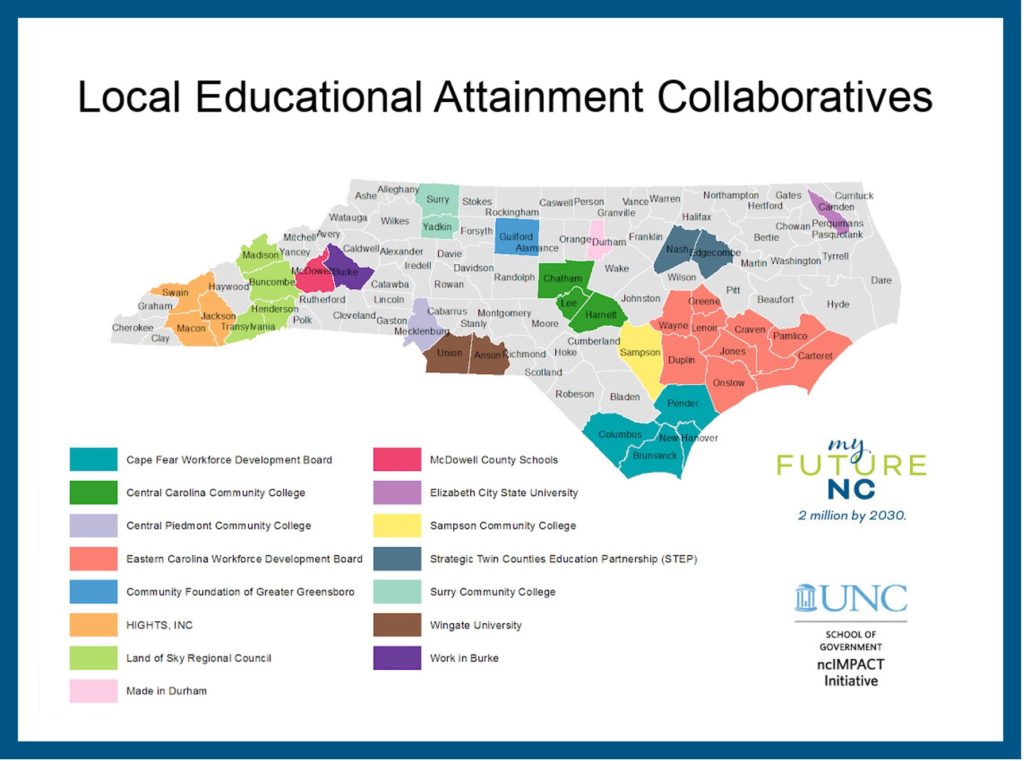

|
|
Last week, the ncIMPACT Initiative at the UNC School of Government concluded a two-year pilot program that supported 15 local education attainment collaboratives (LEACs) from across the state. These collaboratives were tasked with increasing the attainment of high-quality degrees and credentials in their regions.
The program, in partnership with myFutureNC, aligns with a statewide goal of ensuring that 2 million North Carolinians have a postsecondary degree or credential by 2030.
Over the last 18 months, ncIMPACT has guided these local collaboratives in establishing goals, identifying strategies, planning for implementation, collaborating across sectors, and learning from experts over a series of forums. This was the fifth and final forum.
The progress made so far
To open the forum, Anita Brown-Graham, director of ncIMPACT initiative, took time to reflect on the process and progress of the last 18 months.
Brown-Graham emphasized the big idea: it takes cross-sector collaboration to meet some, but not all, opportunities. This is where these LEACs come into play. With the help of myFutureNC and ncIMPACT, collaboratives were pushed to create meaningful partnerships in their communities and look at increasing educational attainment from the bottom up.
“We asked teams to talk about, ‘What is your reality?'” Brown-Graham said.
Collaboratives have been paired with regional impact managers, who help engage with local communities and increase growth efforts.
Over the last 18 months, teams have also grown. They’ve learned what works for their regions. They’ve learned how to navigate cross-sector partnerships. They’ve learned to “be champions” and continue the work when it’s difficult. But, Brown-Graham said the “most valuable” learning that teams gained was from each other.
Learning to navigate challenges
Brown-Graham also reminded collaboratives of the tougher parts of the journey.
Collaboratives began this work with ncIMPACT in mid-2021, during the height of the pandemic. Teams had to learn how to continue this work coupled with COVID-19-related learning loss in schools. Some teams immediately tackled this issue and incorporated it into their long-term goals.
Whether it’s a global pandemic or anything else, Brown-Graham encouraged teams to not let future challenges deter their progress. Instead, she reminded teams that challenges are to be expected.
“In reality, life always happens,” she said. “I caution all of you when thinking about launching into your communities to recognize you’re going to have some mountains to climb, some valleys to cross, and live a few thunderstorms, hurricanes, tornadoes.”












Who are the collaboratives?
There are 15 collaboratives across the state. These include:
- Achieve HIGHTS!
- Central Carolina Connections: Chatham, Harnett, Lee County Collaborative
- Durham’s Opportunity Collaborative
- Empower NE NC: An Educational Collaborative
- GuilfordJobs2030
- Land of Sky Education & Workforce Collaborative
- McDowell Pipeline: Growing our Own
- Our Future Cape Fear: A Roadmap to Meaningful Careers
- Our future in UNiSON
- OurFutureE3NC Educate. Equip. Excel.
- Queen City Collaborative
- Sampson Connect
- STEP: #workHERE Collaborative
- Surry-Yadkin_IMPACT
- Work in Burke


When this work began in 2021, each collaborative brought their own unique experiences to the work. Some, like Work in Burke and #workHERE, existed before joining the network of LEACs. Others, like Sampson Connect and GuilfordJobs2030, began their work when they joined the network.
Whether they’re early in the process or years in, teams say participating in this network has changed the way they approach their work.
“We’ve changed our lens in the past year and that has been really key,” Sarah Crisp, program manager for Work in Burke, said. “This LEAC program has really helped Work in Burke move away from this cyclical programming that we’ve had with yearly events and things like that, to look more broadly at system and transformational change.”
A look ahead
As the LEACs transition, teams are receiving a toolkit to implement and sustain local collaboration with regional employers. Regional impact managers will also keep in touch with collaboratives and continue to provide guidance.
While collaboratives are wrapping up their time in the program, Cecilia Holden, president and CEO of myFutureNC, said the work doesn’t stop here. She encouraged teams to stay in contact with their regional impact managers so that together, they can go deeper into the work on a county and regional level.
“We remain committed to you,” Holden said.
Moving forward, Holden said collaboratives should involve county commissioners, school boards, community college trustees, and business and local industry partners. In order to reach the state’s education attainment goal, Holden said this cross-sector collaboration is vital.
“Everybody needs to hear what this is about,” Holden said. “I would encourage the local educational attainment collaboratives to have the conversation.”
According to the myFutureNC dashboard, North Carolina had an estimated 1,555,543 adults 25-44 with a high-quality degree or credential as of 2021. This is 31,000 individuals below where the state needs to be to stay on target for the 2 million by 2030 goal.
“We cannot make 2 million by 2030 but for you,” Holden said. “We are committed.”





